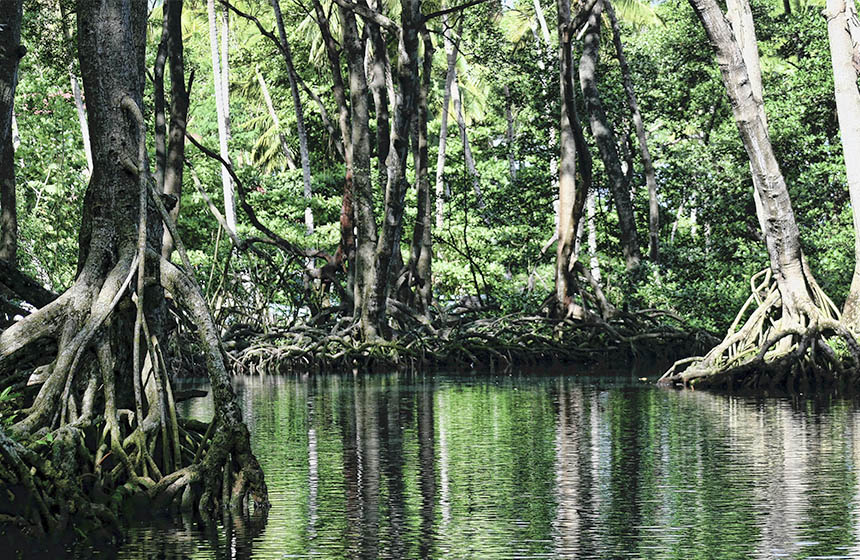Flood recovery and mangrove reforestation in the Limpopo River Estuary
Communities surrounding the Limpopo River Estuary maintain a mangrove nursery, plant seedlings, and monitor the state of reforested areas. The reforested areas have already been found to provide improved flood protection, reduce salt intrusion on agricultural land, and bring back previously diminished wildlife species.
Nature-based Intervention:
Starting in 2008, 58 community members began restoring the channels that had previously connected the mangroves with the tides. Two years later, a mangrove nursery was created, which has to date produced 168,367 seedlings of six different mangrove varieties, and 200 community members have begun replanting. Seedlings have survived at a rate of 74% after community monitors responded to the threat of grazing crabs by covering seedlings with reeds. Seeing the benefits of the restored mangrove for agriculture, wildlife, and flood protection (another incident of severe flooding occurred in 2013 with significantly less damage), community members ultimately imposed a ban on forest product extraction in the reforestation zone.
Overview of context and outcomes:
In 2000, heavy rains caused devastating flooding of the Limpopo River Estuary. The flooding left mangrove forests uprooted and vulnerable to dieback. Although the mangrove forests in the estuary had previously been weakened due to both human and environmental pressures, they still served an important ecological and economic role for the surrounding communities.
Case effectiveness on
Climate change
Although not quantified, the replanting of a previously weakened mangrove ecosystem will likely contribute to climate change mitigation on a small scale.
The reported restoration of mangrove forests will likely protect communities from increased flooding caused by climate change induced changes in rainfall and sea level rise. Already after a serious flood impacted the area again in 2013, community members reported less severe impacts compared to the 2000 flood. Community members partly attribute this difference to the mangrove reforestation efforts.
Ecosystem health
Ecological effect: PositiveBy 2013, 100 hectares of mangroves had been reforested with an observed seedling survival rate of 74%. A community leader reported that several species of fish that had previously disappeared from the estuary had since returned.
Socioeconomic outcomes
Communities have shifted from timber harvesting and cattle grazing to more sustainable livelihood practices such as crabbing, tilapia farming, and mangrove honey production. Areas sheltered by restored mangroves have reportedly rendered fisheries more stable and profitable. Each community member participating in mangrove replanting was provided with a small remuneration. Ten permanent positions managing the mangrove nursery and monitoring reforestation progress have been created. The strengthened mangroves have reportedly reduced salt water intrusion on agricultural land increasing productivity and likely bolstering food security. Seeing as women are primarily responsible for subsistence farming in the area, they have since become much more active in the conservation and reforestation efforts.
Governance
The project is governed by the Centre for Sustainable
Development of the Coastal Zones which works with local community leaders and members to implement the project.
Finance
The project was initially funded by the Centre for Sustainable Development of the Coastal Zones which is a autonomous institution under the Ministry of Land, Environment and Rural Development focused on providing technical assistance.
Monitoring and evaluation
Ten community members were paid to assist with management and monitoring of the site. Most of this monitoring focuses on the tidal channels and protecting seedlings from grazing pressure.
Trade-offs and limitations
A large limitation for the project is sustainable financing. Current financial flows can be irregular which jeopardizes the stability of the project.

Intervention type
- Protection
- Restoration
Ecosystem type
- Mangroves
Climate change impacts addressed
- Loss of food production
- Coastal inundation
- Coastal salt water intrusion
Instigators
- Community/self driven
- National environment and development organization
Societal challenges
- Biodiversity conservation
- Climate change adaptation
- Disaster risk reduction
- Economic and Social development
- Food security
Outcomes
- Food security: Positive
- Water security: Not reported
- Health: Not reported
- Local economics: Positive
- Livelihoods/goods/basic needs: Not reported
- Energy security: Not reported
- Disaster risk reduction: Positive
- Rights/empowerment/equality: Not reported
- Conflict and security: Positive
- No. developmental outcomes reported: 5
Resources
Read resource 1Literature info
- Grey literature



